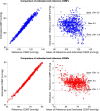Leveraging the potential of machine learning for assessing vascular ageing: state-of-the-art and future research
- PMID: 35316972
- PMCID: PMC7612526
- DOI: 10.1093/ehjdh/ztab089
Leveraging the potential of machine learning for assessing vascular ageing: state-of-the-art and future research
Abstract
Vascular ageing biomarkers have been found to be predictive of cardiovascular risk independently of classical risk factors, yet are not widely used in clinical practice. In this review, we present two basic approaches for using machine learning (ML) to assess vascular age: parameter estimation and risk classification. We then summarize their role in developing new techniques to assess vascular ageing quickly and accurately. We discuss the methods used to validate ML-based markers, the evidence for their clinical utility, and key directions for future research. The review is complemented by case studies of the use of ML in vascular age assessment which can be replicated using freely available data and code.
Keywords: Arterial stiffness; Blood pressure; Cardiovascular; Central blood pressure; Machine learning; Pulse wave velocity.
Conflict of interest statement
Conflict of interest: none declared.
Figures


 , presence of CV event;
, presence of CV event;  , absence of CV event. Adapted from: ‘
, absence of CV event. Adapted from: ‘


Similar articles
-
Developing technologies to assess vascular ageing: a roadmap from VascAgeNet.Physiol Meas. 2024 Dec 30;45(12):121001. doi: 10.1088/1361-6579/ad548e. Physiol Meas. 2024. PMID: 38838703 Free PMC article. Review.
-
Estimating pulse wave velocity from the radial pressure wave using machine learning algorithms.PLoS One. 2021 Jun 28;16(6):e0245026. doi: 10.1371/journal.pone.0245026. eCollection 2021. PLoS One. 2021. PMID: 34181640 Free PMC article.
-
Arterial wall elasticity: state of the art and future prospects.Diagn Interv Imaging. 2013 May;94(5):561-9. doi: 10.1016/j.diii.2013.01.025. Epub 2013 Apr 22. Diagn Interv Imaging. 2013. PMID: 23619291 Review.
-
Identifying Early Vascular Ageing in Patients With Metabolic Syndrome: Unresolved Issues and a Proposed Novel VAmets Score.Heart Lung Circ. 2021 Nov;30(11):1752-1761. doi: 10.1016/j.hlc.2021.06.533. Epub 2021 Aug 20. Heart Lung Circ. 2021. PMID: 34426074
-
Serum uric acid: a futile bystander in endothelial function?Blood Press. 2023 Dec;32(1):2237123. doi: 10.1080/08037051.2023.2237123. Blood Press. 2023. PMID: 37470459
Cited by
-
Development of a recommendation system and data analysis in personalized medicine: an approach towards healthy vascular ageing.Health Inf Sci Syst. 2024 May 3;12(1):34. doi: 10.1007/s13755-024-00292-9. eCollection 2024 Dec. Health Inf Sci Syst. 2024. PMID: 38707839
-
Heart Failure: Insights From the Arterial Waves.J Am Heart Assoc. 2023 Mar 21;12(6):e029116. doi: 10.1161/JAHA.123.029116. Epub 2023 Mar 9. J Am Heart Assoc. 2023. PMID: 36892064 Free PMC article. No abstract available.
-
Expert Consensus on the Clinical Use of Pulse Wave Velocity in Asia.Pulse (Basel). 2022 Nov 22;10(1-4):1-18. doi: 10.1159/000528208. eCollection 2022 Dec. Pulse (Basel). 2022. PMID: 36660436 Free PMC article.
-
Overnight stiffness index from finger photoplethysmography in relation to markers of cardiovascular risk and vascular ageing.Heart Vessels. 2025 Mar 14. doi: 10.1007/s00380-025-02537-3. Online ahead of print. Heart Vessels. 2025. PMID: 40085218
-
Developing technologies to assess vascular ageing: a roadmap from VascAgeNet.Physiol Meas. 2024 Dec 30;45(12):121001. doi: 10.1088/1361-6579/ad548e. Physiol Meas. 2024. PMID: 38838703 Free PMC article. Review.
References
-
- McEniery CM, Yasmin Hall IR, Qasem A, Wilkinson IB, Cockcroft JR. Normal vascular aging: differential effects on wave reflection and aortic pulse wave velocity: the Anglo-Cardiff Collaborative Trial (ACCT). J Am Coll Cardiol 2005;46:1753–1760. - PubMed
-
- Laurent S. Defining vascular aging and cardiovascular risk. J Hypertens 2012;30:S3–S8. - PubMed
-
- Climie RE, Mayer CC, Bruno RM, Hametner B. Addressing the unmet needs of measuring vascular ageing in clinical practice-European cooperation in science and technology action VascAgeNet. Artery Res 2020;26:71–75.
Grants and funding
LinkOut - more resources
Full Text Sources
